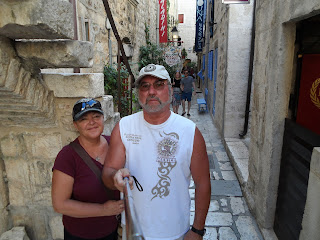Hvar
We took the ferry across to Hvar from Drvenik on a very busy Saturday afternoon. By the time we arrived at the ferry landing, the line of cars, trucks and campers stretched for what seemed like miles. When a ferry arrived and unloaded, then loaded, the line seemed to barely move. We waited for three more ferries and two hours before we were able to load, then cross the 35 minute trip to Hvar Island.
Hvar, the island in Adriatic Sea , is the longest and the sunniest Croatian island and one of the most beautiful islands in the world. It is a part of the central Dalmatian archipelago with the area of 299.6 sq km. The road we travelled on would rival the “Tail of the Dragon” the infamous motorcycle route in Deal's Gap, South Carolina. The 11-mile stretch of the Dragon in Tennessee boasts some 318 curves. The Dragon's sharpest curves have names like Copperhead Corner, Hog Pen Bend, and Wheelie Hell. Our stretch of road to our little village of Jelsa was only 52 km long, but it took us 75 minutes, which means we averaged about 40 km/hour or 24 mph for our American friends. The scenery was breathtaking, with fabulous views of mountains, sparkling seas, olive trees, lavender, grapevines, rock walls, and purple bougainvilla.
The rock walls, built with an ancient technique called dry construction because it uses no mortar, were a bit of a mystery as they seemed to follow no logic or pattern, sometimes stretching off into the mountainous distance, sometimes dividing out small parcels of land, sometimes seeming to be the basis for some long-disused hut or small building. It turns out that as early as the 4th century, farmers picked the rocks out of the stony ground to create small areas for growing olive trees, and then stacked them to form walls that demarcated ownership. In some cases, the walls were strategically placed to provide shelter for sheep or goats. Over time, these walls grew to stretch randomly for kilometers.
Our first dinner in Jelsa was at Konaba Nono, steak for me and seafood risotto for Sweet Lorraine. It was good enough to convince us to make a reservation for the lamb dinner that required 24 hours notice to prepare. It did not disappoint, as the large cast iron pan was steaming with delicious lamb, garlic, onions, tomatoes, potatoes and broth. It was a big meal, but I think we did it justice.
Later, we met a friend of Christina Gelinas' named Bekim who has opened a terrific little ice-cream and dessert cafe. When we told him we were friends with Christina, he treated us like family, and we sat down for a delcious dessert and Croatian liquor, none of which we were allowed to pay for.
The next day we took a scooter and rode to Hvar Town for a lunch of calamari and salad by the sea. Imposing fortifications stand guard over a field of orange rooftops that slope down to the crystal blue waters. The remains of walls built by a long list of invaders descend towards the wide promenade edging the brilliant blue sea and the quaint fishing harbor. Marble streets reveal one of the largest squares in Dalmatia, Trg Sveti Stjepana as well as the prized Cathedral of St. Stjepan and the Renaissance theatre.
The Town Square in Hvar is among the most beautiful and the largest in Croatia, but we spent little time there as we wandered the back streets, stumbling upon tiny little courtyard cafes and bars, all nestled in nooks and crannies between the ancient stone walls. Bougainvilla, lemon and orange trees wove their way up between the tables to create a fantasy setting. We set out for Dubrovnik the next day and just missed the ferry as it was pulling away, so we took the time to do our power-walking along the sea, returning an hour later to catch the ferry back across to mainland Croatia.
 |
| Bougainvilla above our Room |
Selfie-stick Capture of the Back Alleys of Hvar Town
 |
| Beautiful Main Square in Hvar Town |
 |
| Dry Construction Stone Walls |
 |
| Jelsa, our Home City on Hvar |


No comments:
Post a Comment